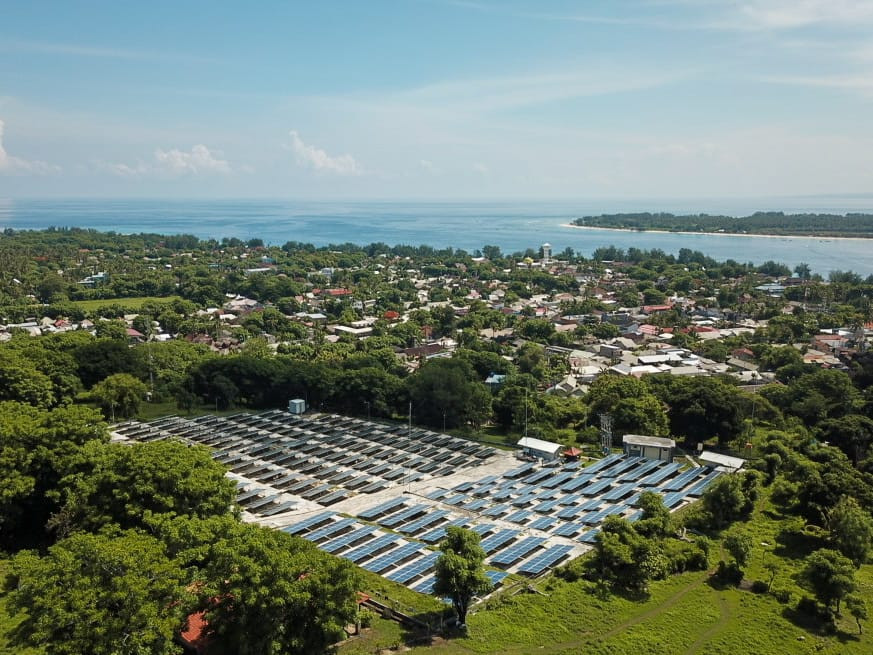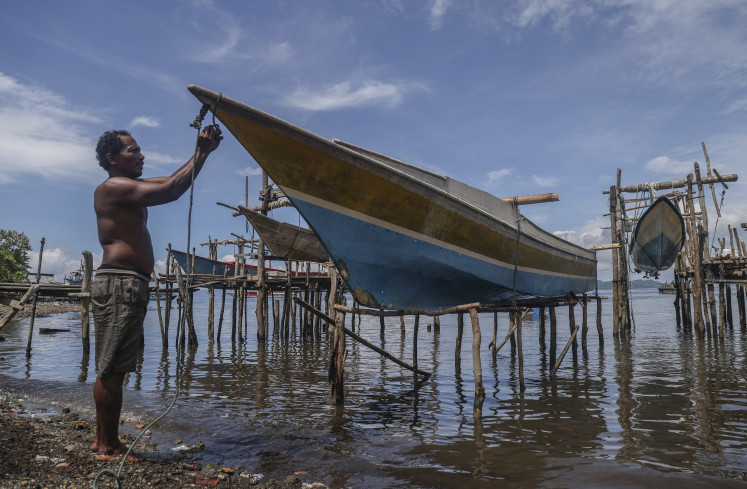Popular Reads
Top Results
Can't find what you're looking for?
View all search resultsPopular Reads
Top Results
Can't find what you're looking for?
View all search resultsIndonesia’s huge solar power potential still going to waste
Floating solar power installations are perceived as more attractive since no land is required and grid interconnections are available for certain dams.
Change text size
Gift Premium Articles
to Anyone
R
enewables have proven their resilience amid the pandemic. The International Energy Agency (IEA) recorded an all-time high of added renewable energy capacity in the first half of 2020, with 30 gigawatts of the total 50 GW coming from solar.
Vietnam is the new solar celebrity, after a long dependence on coal. An apparent energy crisis, technological advancement in solar photovoltaic, the declining price of solar power and the climate crisis have created a turning point in Vietnam. At the end of 2020, after growing 2,400 percent within a year, solar installations in Vietnam produced 16.5 GW of electricity, which compares to virtually none in 2017.
Indonesia pales in comparison. If examples from European or Middle Eastern countries are often perceived as less relevant to the Indonesian context – Vietnam's success should be cherished. A fellow Southeast Asian country has succeeded with no secret recipe, just strong government commitment, a long-term power development plan favoring renewables, effective pricing policies and a long list of incentives (e.g., land-fee exemptions), as well as a one-stop-service with state-owned utility EVN.
Here in Indonesia, a presidential decree on the renewable energy price has yet to be issued after more than a year of preparation. The 10-year electricity plan (RUPTL) of state-owned power company PLN will be released soon. An additional capacity of 3.7 GW of "various renewables" is said to be included, but the solar energy share is still unclear. A "grand strategy" for renewables to achieve the National Energy Plan target of 23 percent renewables by 2025 and more by 2035 has been made public by the Energy and Mineral Resources Ministry, in which solar energy is given priority with more floating solar projects, a replacement of diesel generators with solar power plants and a planned solar park in eastern Indonesia.
But until there is strong commitment for a long-term expansion of solar power with a clear development plan, including supporting regulations and incentives, Indonesia will always be on the sidelines. This situation is exacerbated by growing doubts over the role of solar energy in Indonesia. Solar has entered Indonesia's mainstream energy discourse – now come all the doubts, including from utilities and solar power skeptics.
The first of those doubts concerns the energy yield. While solar irradiation in Indonesia (3.4- 6.2 kilowatt hours (kWh)/m2/day) is evidently lower than in the United Arab Emirates (5.5-6.3 kWh/m2/day) but comparable to India (3.2-6.4 kWh/m2/day), our photovoltaic electricity potential is not bad, ranging from 2.8 to 4.8 kWh/kWp/day. Indeed, monsoon, water vapor, air pollution and the local climate may affect the solar power output, but at the end, it is the power output from solar modules that matters.
Our study in 2019 estimated that the generation potential translates into a levelized cost of electricity of 5.84-10.28 US cent/kWh for utility-scale solar, quite on-par with coal-generated electricity.
Land is another concern. With the highest commercial panel efficiency of around 23 percent, a typical 1 MW solar power plant in Indonesia requires 1.25-1.6 hectares. This land issue, however, is a solvable problem, and learning from other countries' success, identifying suitable sights is key.
Recently, we conducted a nationwide solar potential mapping based on geographic information, allowing a closer examination on available, suitable land for potential solar projects at the city/regency level. This could assist the government in determining location priorities for solar deployment.
Rooftop solar is also a case in point, as its application on government buildings, residential areas, commercial and industrial (C&I) facilities has thrived. Our Indonesia Energy Transition Outlook 2021 predicted that C&I will lead the trend as more companies implement energy management and seek to keep their climate commitments. Megawatt-sized rooftop solar installation is no longer a rarity. Last year, Coca Cola Amatil's 7.13 MWp and Danone Aqua's 2.91 MWp installations came online.
Following the commencement of work on the Cirata 145 MW floating solar project and the regulatory update from the Public Works and Housing Ministry allowing 5 percent of man-made reservoirs for solar power plants, the investment climate has brightened. Floating solar is perceived as more attractive, since no land is required and grid interconnections are also available for certain dams – these two could drive down costs and ease project development.
Our recent analysis also found a floating solar potential of 723 MWp on 42 dams across Central Java alone, which the provincial government is keen to offer to potential investors.
Next doubt: solar e-waste. The International Renewable Energy Agency (IRENA) projected that, by 2050, the world would be producing 6 million metric tons of solar e-waste annually. While arguably the number is a small percentage of more than 54 million metric tons of total e-waste generated per year (and that was back in 2019), the question remains how ready Indonesia is to treat solar e-waste. Research and development efforts globally have been united in solving this problem in an attempt to increase the effectiveness of recycling.
Several recycling technologies offered even reach 96 percent recycling efficiency – with ongoing innovation to optimize solutions and minimize trade-offs. At this infant stage of solar development in Indonesia, a plan for proper solar panel recycling could be established by taking into account technological progress, required policies and incentives as well as the volume of waste.
It is not impossible that, in the future, solar energy, combined with storage technologies and smart grids, can power the entire electricity demand. Large-scale solar deployment can help Indonesia cement ambitious climate mitigation targets beyond the nationally determined contribution. In the Java-Bali and Sumatra systems, floating solar on reservoirs and lakes is viable, while ground-mounted solar with energy storage systems can be developed on other islands to replace old thermal power plants.
A short-term target would be rooftop solar for commercial, industrial and residential buildings. One of the important measures to unleash this potential is the revision of Energy Ministry Regulation No. 49/2018 to allow for better net-metering tariffs and more efficient on-grid application.
But the bottom line is that President Joko “Jokowi” Widodo must realize the vast potential of Indonesia’s solar energy and make a bold commitment and plan of action to develop solar photovoltaics – declaring solar power a national strategic project and paving the way for a clean energy transition in Indonesia.
***
Fabby Tumiwa is the executive director of the Institute for Essential Services Reform (IESR), and Marlistya Citraningrum is the managing director of SolarHub by IESR.










